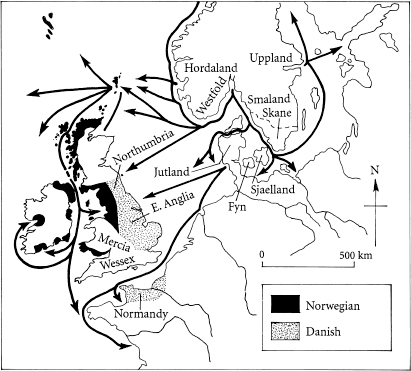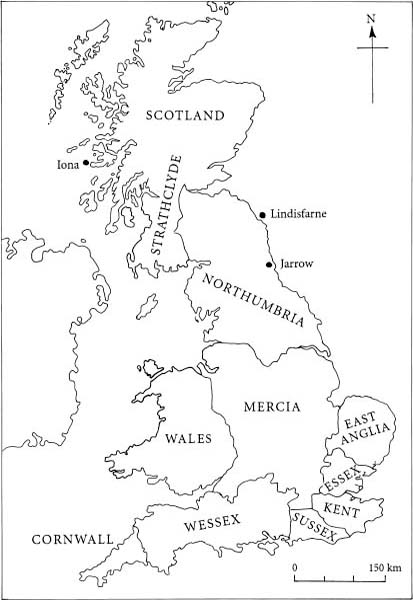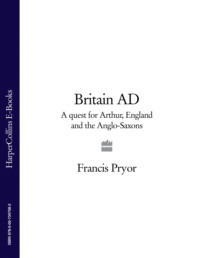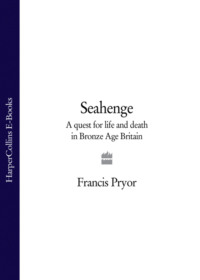
Полная версия
Britain in the Middle Ages: An Archaeological History
There is now no doubt that close links existed between Later Saxon southern Britain and its neighbours around the southern North Sea basin. Further north and west the situation was rather different. As we have seen, development here was slower and less affected by outside influences, a situation which was soon to be exploited by those remarkable entrepreneurs the Vikings. Our understanding of the period has changed in two important respects. First, we now see the Middle Saxon period in southern Britain as altogether more dynamic and cosmopolitan than hitherto. Second, we no longer see the Vikings as just being a force for evil – a view, as we will see, that was fostered by King Alfred, who is increasingly being acknowledged as a master of political propaganda. So what were the Vikings really like?
CHAPTER TWO Enter the Vikings
THE LATE SAXON PERIOD (850–1066) has been poorly taught at schools, and I cannot blame the teachers altogether for this. There are too many kings with strange names beginning with Æ. Viking armies seem to whizz about the place generally wreaking havoc, and worst of all, it seems somehow rather uncivilised. In actual fact, and largely thanks to archaeology, we now realise that many of the advances made in Middle Saxon times were consolidated and built upon in the Late Saxon period. Indeed, it must now be seen as one of the most creative periods in English history. Certainly there was strife and conflict, but at the same time the administrative framework of the country was being established. The Church was gaining a firm foothold, patterns of land ownership and tenure were being established, and urban life was to be transformed by the setting up of the first burhs.
Maybe the neglect of archaeology is a reason why so many popular history books relegate the entire Saxon period to a single introductory chapter which usually reads as a prologue to the main business, which happened after 1066. Having considered the Middle Saxon period in the barest outline in Chapter 1, I plan to devote this and the next two chapters to the Late Saxon period. Although it will be impossible to avoid some degree of overlap, the present chapter will mainly be about the Vikings and the historical events surrounding their conflict with the Saxons. Chapters 3 and 4 will consider more general themes, such as the changes that took place in the administration of town and country.
The Late Saxon period is very much better documented than the Middle Saxon period, largely thanks to The Anglo-Saxon Chronicles, which as we will see shortly were set up in the late ninth century. But in both the Middle and Late Saxon periods evidence from field archaeology is having a most dramatic effect on the way we now view the first four centuries of medieval Britain. If one takes the historical record at face value, it would appear that people thought about Dane and Viking raids almost obsessively. Little else, it would seem, occupied their thoughts. But it now appears that the reality was rather different. Yes, raiding did affect people, especially in eastern and northern Britain, but as we have seen, farming, trade and communication were very much more important. But now we must come to grips with the bare bones of the political history – which is another way of saying that it is time to introduce the Vikings.
At first glance there is something wonderfully romantic, even ‘prehistoric’, about those wild Scandinavian warriors. They are strangely attractive, in a horribly bloodthirsty way. I remember on my first visit to Denmark meeting a university colleague who specialised in the archaeology of the Earlier Neolithic. Like me he was fair-haired, with an orange beard. As he shook my hand he said with a broad smile, ‘So you are Viking, I think?’ Suddenly – and quite irrationally – I felt I was part of a Band of Brothers. Had he offered me a horned helmet I would have grabbed it with both hands.
In fact horned helmets are part of the romanticising of the Vikings which began in the nineteenth century. Sadly, despite their evocative profile and terrifying appearance, they were never worn by Nordic warriors. I do, however, know of a very fine Late Iron Age example (probably first century BC), complete with rather fat, straight horns, which was dredged from the River Thames at Waterloo Bridge in 1868.1 Its Celtic-style decoration firmly marks it as being some eight centuries earlier than the first Viking raids.
The word ‘Viking’ does not appear in any contemporary accounts of the period. Instead we read of raids by Danes or Norsemen. Sometimes they simply referred to their attackers as ‘heathen’. The word (which is Old Norse in origin) gained public acceptance in the nineteenth century with the publication of the Icelandic Sagas, and the heroic deeds of the semi-mythical Viking sailors and warriors that appear in them. The Sagas were enormously popular and influential in Victorian Britain, and indeed across much of northern Europe. Today archaeologists tend to use ‘Viking’ as shorthand for ‘Anglo-Scandinavian’, which is the correct way of describing the Norse-influenced way of life to be found at places such as Jorvík (York). In general terms, what one might term the ‘Viking Age’ ends in England in the mid-eleventh century with the Norman Conquest, but we should not forget that places like the Western Isles of Scotland and the Isle of Man remained under Viking rule until 1266. Orkney and Shetland were Norwegian until as late as 1469.
The warlike reputation of the Vikings was justified, because we do know that they raided extensively in northern Europe, and even crossed the Atlantic to Greenland and Newfoundland in Canada. But there was a great deal more to them than that. Raiding was part of what they did, but it was probably a relatively minor part. In fact they were very much more constructive and, dare I say it, useful. Today many archaeologists question whether there was ever a group of people who saw themselves as distinctively Viking, as opposed to something less immediately identifiable, such as Nordic or Norse. It is also questionable to what extent the term Viking can actually be attached to a defined ethnic group. This is perhaps understandable: viewed from the perspective of a Saxon peasant in eastern England, it wouldn’t matter a jot whether the raiders were members of the same tribe, nation or kingdom, because they were all equally unwelcome.
The Vikings are as popular in print as they have ever been, and some of the more recent accounts are also very well illustrated.2 The Anglo-Saxon Chronicles contain the earliest account of a Viking raid on a British monastery, which took place on 8 January 793 on the island of Lindisfarne, just off the Northumberland coast. The ‘heathen’ raiders sacked the buildings, killed several monks and took others captive. They also desecrated altars and helped themselves to valuables which may have included the richly decorated original covers of the world-famous Lindisfarne Gospels, now in the British Museum.
The picture of heathens from abroad mercilessly raiding Christian shrines is a vivid one, but raiding was characteristic of the times. We know of many raids, especially around the Irish Sea, by British on Irish and vice versa. The Vikings were not the only people doing it. We also tend to think of northern and eastern England – what was soon to be called the Danelaw – as the main object of Viking depredations. But in fact other parts of the British Isles also received many and repeated visits from Viking raiders and settlers. It was a complex picture, not least because the Vikings were coming from many parts of Scandinavia. As a rule of thumb, people from Norway colonised the north and west of Britain, and Ireland. Danes came to eastern England and north-west France (Normandy).

FIG 7 The general pattern of Viking raids and migrations in north-western Europe from just before AD 800 until the eleventh century.
Their non-existent horned helmets aside, the Vikings are justly celebrated for their superbly graceful, clinker-built sea-going vessels, known as longships. The tradition of clinker building in northern Europe predates the Vikings, and was to persist until the fifteenth century for large sea-going vessels, when it was replaced by carvel or frame construction.* The Viking longship was a superb vessel. I remember coming across one in a rather run-down state, very dusty and liberally spattered with pigeon droppings, in a shelter on the shore of Lake Michigan in Chicago. A faded plaque declared that she was a full-scale replica that had been sailed across the Atlantic for the World Columbian Exposition of 1893. The Viking, as she was named, was a copy of the Gokstad ship which was discovered in Norway in 1880. 3Nobody was around, so I had a Viking longship that had crossed the Atlantic all to myself for an hour or so, until it started to get dark. It was an experience I will never forget.
The first thing that struck me about the Viking was her size. She seemed tiny for a vessel that could take the worst that the North Atlantic had to offer. I was reminded of this ten years later when I visited the Viking Ship Museum in Roskilde, Denmark, in 1987. I was on a circuit of Continental tourist attractions as part of the feasibility study I undertook before we opened Flag Fen to the public. I had spent the morning sampling the delights of Legoland, and was eager to escape clever things made from plastic bricks, so I headed out to Roskilde. I was looking across the harbour when I noticed that in amongst the yachts and pleasure craft was a replica Viking ship (a large one, but not one of the ocean-going warships), with another, much smaller boat moored at the shore. By modern standards they were tiny.
Maritime archaeologists have realised that many of the handling characteristics of full-sized vessels can be replicated in half-scale models, with the help of some simple mathematics.4 These smaller vessels also present the shipwrights involved in their construction with most of the technical challenges faced by their ancient counterparts, but at considerably reduced expense. So far half-scale models have been constructed of a smaller Viking-age vessel, the fourteen-metre clinker-built Graveney boat, which it is estimated could have carried a cargo of six to seven tonnes. This vessel, which was abandoned in the mid-tenth century, was carrying a cargo that included (presumably Kentish) hops – comprehensively destroying the myth that all medieval ale was unhopped. The half-scale model of the Sutton Hoo ship, a twenty-eight-metre vessel, has been named the Sae Wylfing. I have seen her in action, and I was particularly impressed by her lightness – she could easily be dragged up onto a sloping beach by her crew, and would not require a quay unless heavily laden. The constructors of the Sae Wylfing were so impressed with her handling in rough water that they were inclined to attribute much of the political success of the builders of her original to such vessels.5 It is thought that the Sutton Hoo vessel was buried within a barrow mound to commemorate or conceal the last remains of King Raedwald of Essex, one of the Wuffingas, the early kings of Saxon East Anglia.
Boat or maritime archaeology has become a sub-discipline in its own right, and landlubbers are advised to walk its companionways with extreme caution. Its practitioners can be as ferocious as Captain Bligh. So the point I want to make has to be simple: yes, ocean-going Viking longships were quite probably the finest open clinker-built vessels ever built, but they were not the only ships afloat at the time – we know of many humbler boats from Viking Britain – and they were not ‘the reason’, as I was taught at school, that the Vikings voyaged abroad. The Vikings came first, the ships second. In other words, the longships were built because the men who sailed them wanted to travel and had the necessary skills to build them.6 It was not the other way around.
It should also be stressed that Viking longships did not appear, as it were, out of the blue. They can be seen to form part of an evolutionary tree whose roots probably extended back to the Early Bronze Age, around 1900 BC, when the first plank-built boats (found at Ferriby on the Humber) made their appearance. These boats could have crossed the Channel, and were probably used for trade along the coast. By the Late Bronze Age (say 1000 BC) trade and exchange around the North Sea was taking place on a regular basis. During Roman times Britain exported huge amounts of grain across the Channel to feed the later Roman field armies. We know that the Anglo-Saxons were excellent sailors, and we have evidence for this in the clinker-built ship from Sutton Hoo, dating to around AD 625. This vessel superficially resembles a Viking longship, and would have been perfectly capable of crossing the North Sea. And of course in the previous chapter we saw the extent of trade throughout northern Europe in the Middle Saxon period and afterwards. So Viking ships, like the Viking phenomenon in general, were part of a process that had roots many centuries old.
Viking warships, and some Viking art, were intended to strike terror into their enemies, and in this they undoubtedly succeeded, because images of Viking ships, such as that in wrought iron on the door of Stillingfleet Church, North Yorkshire, continued to appear even after the immediate threat had passed.
If we are to appreciate the impact of the Vikings on southern Britain, we must briefly go back to the Middle Saxon period and say a few words about the relationship of the Vikings, in what would later be known as the Danelaw, to the two major Saxon territories west of them, the Mercians in the Midlands and the West Saxons in Wessex. Many will know of Wessex and King Alfred the Great in the ninth century, but Mercia, under great rulers such as Offa, was of comparable power in the previous century.
Those of us who have the good fortune to live in the middle of England have always believed that we live in the belly of the place. What the Midlands digests, England consumes; this is the part of the country where we are proud to make and grow things, and where you find the best beer and the warmest people. In the Saxon period the Midlands was synonymous with the kingdom of Mercia. It was the most powerful kingdom of Anglo-Saxon England in the first part of the Middle Saxon period (late seventh and eighth centuries). The heart of Mercia was the middle Trent Valley. This is where its episcopal centre, Lichfield (founded 669), and two royal sites, at Tamworth and Repton, were located. As we will see, Repton is currently being excavated, and is producing very exciting results. Mercia’s early kings Penda and his son Wulfhere were aggressive soldiers, and managed to exact tribute payments from all around: from southern Anglo-Saxon kingdoms, from British kingdoms to the west, and from Northumbria.
Mercian power peaked in the eighth century with two kings, Æthalbald* and Offa (757–96); the latter is mainly remembered today for the construction of Offa’s Dyke, a massive earthwork which runs north – south for 192 kilometres between England and Wales. It consists of a bank to the east and a ditch to the west, so defenders could stand atop the bank and shower attackers with rocks, spears, arrows and anything else that came to hand while they struggled across the ditch and up the steep slope. The positioning of the bank behind the ditch clearly suggests that the earthwork was built to defend the territory of Mercia from attacks from Wales and the west. At first glance Offa’s Dyke seems like a single massive construction, but research by Sir Cyril Fox in the 1950s showed it to have been built in a series of sections, some of which don’t marry up too well.7 Fox suggested that it was essentially a symbolic ‘line in the sand’ created by the might of Mercia against the altogether more puny Welsh. More recently, detailed survey and excavation by Dr David Hill of Manchester University has shown that it was constructed in earnest as a defensive work against concerted attacks from the powerful Welsh kingdom of Powys.8 It was a serious piece of military engineering, probably regularly patrolled by Mercian troops and linked to a system of warning beacons. Anglo-Saxon beacons were an important military tool and consisted of large thatched bonfires which were always at the ready.

FIG 8 The principal kingdoms of Britain in the late eighth century (Middle Saxon period).
Contrary to popular belief, Offa’s Dyke does not extend from sea to sea across the entire eastern approaches to Wales. In fact the original Mercian earthwork is only found across the central part of Wales – a stretch of just over a hundred kilometres. The rest is unprotected, and David Hill believes that this stretch represents the boundary between Mercia and Powys, the source of the principal recurrent threat. Mercia was not at war with the kingdoms of Gwynedd to the north, or with Ercing or Gwent to the south. So that was the boundary Offa defended – there was no point in doing any more. This tells us that boundaries and political treaties were generally honoured. It also tells us that Offa was a pragmatist, and was not about to do anything that was not strictly necessary. It is known that Offa lost Mercian land to the kingdom of Powys in the mid-eighth century, and David Hill regards the Dyke as a fallback position to ensure that there were no further incursions into his territory.
The massive expansion of Mercia in the eighth century gave it control of land to the south and east, including, as we have seen, London, Kent and Sussex. If not actual control, Mercia also managed to impose significant influence on Essex, Surrey and East Anglia. Wessex somehow retained its independence. After Offa’s death these new territories were kept within Mercian control by Cenwulf (796–821), but his successor, Beornwulf, could not stem the tide of increasing resentment against Mercia. In the year 825 he was defeated by King Egbert of Wessex at the Battle of Ellendun, and with the battle went Kent, Sussex, Surrey and Essex.
We have seen how the Norse raids began a few years before 800, and for the next three centuries Scandinavian raiders, soldiers and settlers were to play an active part in the development of early medieval Britain. It would be a mistake to think of this time as some sort of ‘Viking Period’, because many parts of Britain remained largely unaffected by these events. It would also be an exaggeration, because although Scandinavian people did influence certain areas a great deal – Viking York or Jorvík, which was captured by the Danish ‘great army’ in 866, is the obvious example – the language and basic culture of most of Britain remained fundamentally the same. In England, families born to the new arrivals often adopted Christianity and soon spoke the native language (Old English). The changes brought about by the Scandinavian ‘presence’, as J.D. Richards* has termed it, were much less far-reaching than the earlier adoption of an Anglo-Saxon way of life, which happened in the three or so post-Roman centuries.
The earliest Viking raids were essentially hit-and-run affairs aimed at rich coastal targets such as monasteries. Monkwearmouth, made famous some sixty years previously by that extraordinary genius the Venerable Bede, was just such a site. After persistent raiding it, and its twin monastery at Jarrow, were abandoned by the monks around 800. Scandinavian raiding turned to settlement quite rapidly in certain outlying areas of Britain, such as the north-western isles of Scotland and the Isle of Man. Strangely, perhaps, Wales seems to have been missed. The story of Norse raiding and settlement in England is recorded in some detail in The Anglo-Saxon Chronicles. This, or rather these, accounts are a fascinating mixture of history and propaganda.
The Anglo-Saxon Chronicles is one of the most important pre-Norman histories of Britain.9 It was established by King Alfred sometime in the 890s. In form it was an annal written in Old English, which was maintained and updated at major ecclesiastical centres, where the monks’ choice of the events worthy of record often reflected local concerns, such as the appointment of a new bishop. Happenings in more distant parts of Britain often failed to get a mention. Julian Richards describes his excitement on being allowed actually to read a copy of the Chronicles in the library at Corpus Christi College, Oxford.10 Like most archaeologists he was extremely keen to read at first hand the account of the Lindisfarne raid of 793. But he was to be sadly disappointed. The copy before him had been made in Winchester, where such far-off events were not thought worthy of inclusion.
The Chronicles begin with the Roman invasion, the account of which was mainly based on Bede, and they were still being updated in the mid-twelfth century, when the project was dropped. Surviving manuscripts are associated with Canterbury, Worcester, York and Abingdon. As Julian Richards discovered, the Chronicles can be patchy as a reliable source on early events, but are much better in their later coverage of the reigns of Alfred (871–99), Æthelred (865–71), Edward the Confessor (1042–66) and the Norman kings. Initially King Alfred set the project in motion for political ends. It was written to glorify his deeds, his reign and the emerging English nation. It does not give the other side of the story. For that, we will shortly turn to archaeology.
We learn from The Anglo-Saxon Chronicles that there was a ‘great army’ from Denmark in eastern England from 865. This force was highly mobile, and it took York the following year. It then went on to capture additional territory in the north of England (Northumbria), the Midlands (Mercia) and East Anglia. This was the land which became known in the eleventh century as the Danelaw – the area in which customary or day-to-day law (for example the rules of land ownership and local government) was influenced by Danish practice.
Alfred, King of Wessex, who ruled from his capital at Winchester from 871 to 899, is generally acknowledged as the first king of England. According to The Anglo-Saxon Chronicles his reign was largely given over to wresting eastern England back from Viking domination. Historians have painted him as an appropriately heroic figure. He is seen as the Great Man who founded England. As the Chronicles which he so astutely set up portray him, he is very much the English hero to the Viking villain. His principal contemporary biographer, Bishop Asser, was a churchman who was recruited to the royal court by Alfred. He wrote his Life of Alfred by 893, and this is the source that most historians draw upon. Laying aside the question of its authenticity, it can hardly be seen as unbiased, written as it was by someone who enjoyed the fruits of royal patronage. Moreover it draws heavily upon The Anglo-Saxon Chronicles, which were themselves a source of pro-Alfred propaganda. Subsequent historians and politicians have added much to this already impossibly noble image. We probably lack the independent sources to form a truly balanced picture of Alfred, but recent work suggests that he may at least have been human rather than superhuman.11 It cannot be denied that while he was a sufficient master of ‘spin’ to make many modern politicians green with envy, his real and lasting achievements were many. He was a ruthless ruler who understood the importance of public opinion. He was the right man for the times in which he lived.
The bare facts of Alfred’s life are clear. He was the youngest brother of King Æthelred I of Wessex. Æthelred fought the first Danish waves of attack on Wessex, which were launched in the autumn of 870 from bases in East Anglia. Eventually he was killed on campaign in April 871. Alfred inherited the throne of Wessex aged just twenty-two. He had already assisted his elder brother in his campaigns against the Danes, and he continued the war vigorously. The Danish Great Army was to be no pushover, however.






